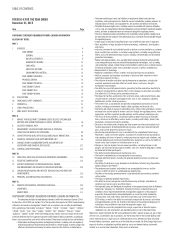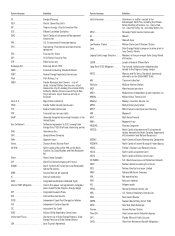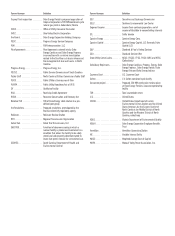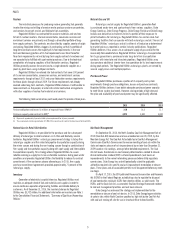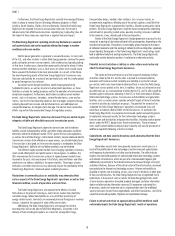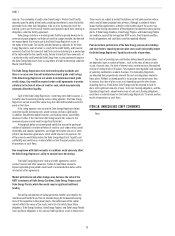Duke Energy 2015 Annual Report Download - page 32
Download and view the complete annual report
Please find page 32 of the 2015 Duke Energy annual report below. You can navigate through the pages in the report by either clicking on the pages listed below, or by using the keyword search tool below to find specific information within the annual report.
PART I
12
17.5 percent upon successful startup of NMC’s polyacetal production facility,
which is expected to occur in January 2017. International Energy will retain
25 percent of the board representation and voting rights of NMC. The investment
in NMC is accounted for under the equity method of accounting.
On February 18, 2016, Duke Energy announced it had initiated a process
to divest the International Energy business segment, excluding the equity
method investment in NMC. The process remains in a preliminary stage and
there have been no binding or non-binding offers requested or submitted. Duke
Energy can provide no assurance that this process will result in a transaction
and there is no specific timeline for execution of a potential transaction.
In December 2014, Duke Energy declared a taxable dividend of historical
foreign earnings in the form of notes payable that resulted in the repatriation
of approximately $2.7 billion in cash held and expected to be generated by
International Energy over a period of up to eight years. For additional information
see Note 22 to the Consolidated Financial Statements, “Income Taxes.”
Customers, Competition and Regulation
International Energy’s customers include retail distributors, electric
utilities, independent power producers, marketers, and industrial and
commercial companies.
International Energy’s sales and marketing of electric power and natural
gas competes directly with other generators and marketers serving its market
areas. Competitors are country and region-specific, but include government-
owned electric generating companies, local distribution companies with
self-generation capability and other privately owned electric generating and
marketing companies. The principal elements of competition are price and
availability, terms of service, flexibility and reliability of service.
A high percentage of International Energy’s portfolio consists of baseload
hydroelectric generation facilities, which compete with other forms of electric
generation available to International Energy’s customers and end-users,
including natural gas and fuel oils. Economic activity, conservation, legislation,
governmental regulations, weather, including rainfall, additional generation
capacities and other factors affect the supply and demand for electricity in the
regions served by International Energy.
International Energy’s operations are subject to both country-specific and
international laws and regulations. See “Environmental Matters” in this section.
COMMERCIAL PORTFOLIO
Commercial Portfolio primarily acquires, builds, develops, and operates
wind and solar renewable generation and energy transmission projects
throughout the continental U.S. The portfolio includes nonregulated renewable
energy, electric transmission, natural gas infrastructure and energy storage
businesses. The segment was renamed in 2015 as a result of the sale of the
nonregulated Midwest generation business, as discussed in Note 2 of the
Consolidated Financial Statements, “Acquisitions and Dispositions.”
Commercial Portfolio’s renewable energy includes utility-scale wind and
solar generation assets which total more than 2,400 MW across 11 states
from more than 22 wind farms and 38 commercial solar farms. Revenues are
primarily generated by selling the power produced from renewable generation
through long-term contracts to utilities, electric cooperatives, municipalities,
and commercial and industrial customers. In most instances, these customers
have obligations under state-mandated renewable energy portfolio standards
or similar state or local renewable energy goals. Energy and renewable energy
credits generated by wind and solar projects are generally sold at contractual
prices. In addition, as wind and solar projects are placed in service, Commercial
Portfolio recognizes either investment tax credits (ITC) when the renewable
project achieves commercial availability or production tax credits (PTC) as
power is generated by the project over 10 years. Renewable ITC are recognized
over the useful life of the asset with the benefit of the tax basis adjustment due
to the ITC recognized in income in the year of commercial availability.
Duke Energy, through its Commercial Portfolio segment, is a 40 percent
equity member of Atlantic Coast Pipeline, LLC, (ACP) that plans to build and
own the proposed Atlantic Coast Pipeline (the pipeline), a 564-mile interstate
natural gas pipeline. The pipeline is intended to transport diverse gas supplies
into southeastern markets. Duke Energy Carolinas and Duke Energy Progress,
among others, will be customers of the pipeline. The estimated in-service
date of the pipeline is late 2018. For additional information on the ACP equity
investment and further details on the proposed pipeline, see Note 4 to the
Consolidated Financial Statements, “Regulatory Matters.”
Commercial Portfolio also has a 7.5 percent equity ownership interest
in the proposed Sabal Trail natural gas pipeline. The Sabal Trail pipeline is
planned to begin service in 2017 and traverse Alabama, Georgia and Florida
to meet rapidly growing demand for natural gas in those states. For additional
information on the Sabal Trail equity investment and further details on the
proposed pipeline, see Note 4 to the Consolidated Financial Statements,
“Regulatory Matters.”
Commercial Portfolio has executed investments to expand and grow
the business through the addition of distributed solar projects, energy storage
systems and energy management solutions specifically tailored to commercial
businesses.
For additional information on Commercial Portfolio’s generation facilities,
see Item 2, “Properties.”
Other Matters
Commercial Portfolio is subject to regulation at the federal level, primarily
from the FERC. Regulations of the FERC govern access to regulated market
information by nonregulated entities, services provided between regulated and
nonregulated utilities, pipeline certification.
For more information on rate matters, see Note 4 to the Consolidated
Financial Statements, “Regulatory Matters – Rate Related Information.”
Market Environment and Competition
The market price of commodities and services, along with the quality
and reliability of services provided, drive competition in the wholesale energy
business. Commercial Portfolio’s main competitors include other nonregulated
generators and wholesale power providers.
Sources of Electricity
Commercial Portfolio relies on wind and solar resources for its generation
of electric energy.
OTHER
The remainder of Duke Energy’s operations is presented as Other. While
it is not an operating segment, Other primarily includes unallocated corporate
interest expense, certain unallocated corporate costs, Bison Insurance Company
Limited (Bison), Duke Energy’s wholly owned, captive insurance subsidiary,
contributions to the Duke Energy Foundation, and other minor and immaterial
investments in businesses the Company retained from previous divestitures
that are no longer part of its current operating segment or is in various stages of
exiting or winding down.
Bison’s principal activities as a captive insurance entity include the
indemnification of various business risks and losses, such as property, workers’
compensation and general liability of Duke Energy subsidiaries and affiliates.
Regulation
Certain entities within Other are subject to the jurisdiction of state and
local agencies.


